Another board full of gauges. Again the order is not always logical. There are gauges on other boards that have close links to some of these. (Click knitting tools in the tags, or categories, to see posts about other gauges.)
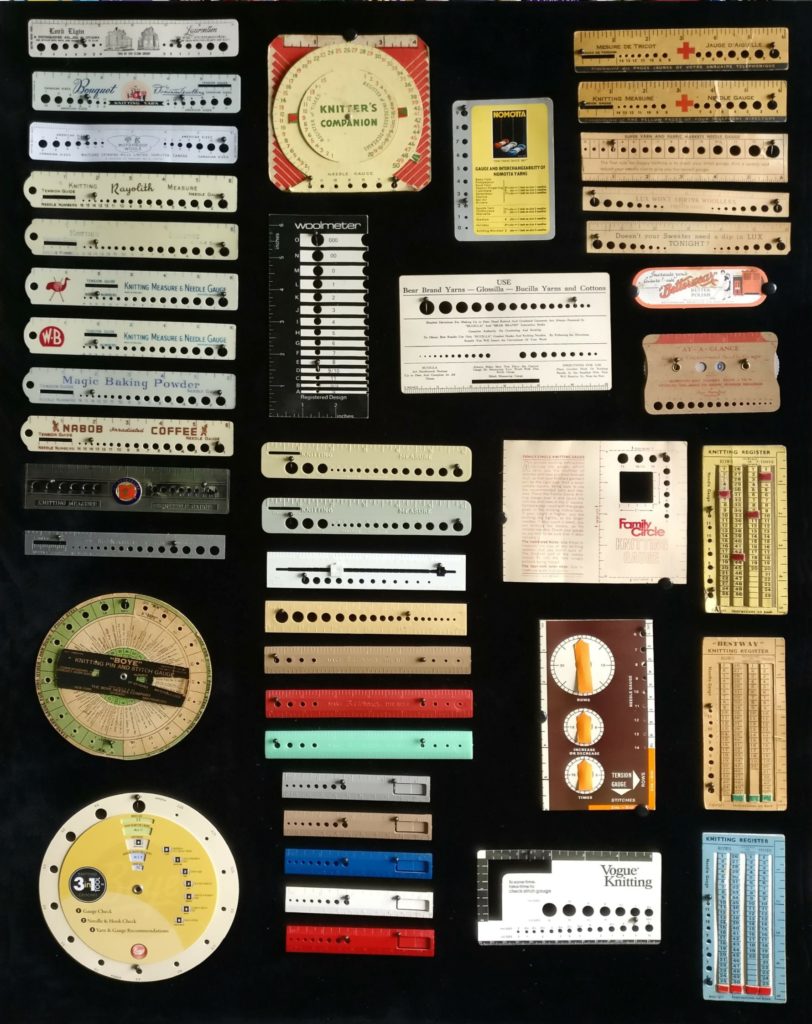
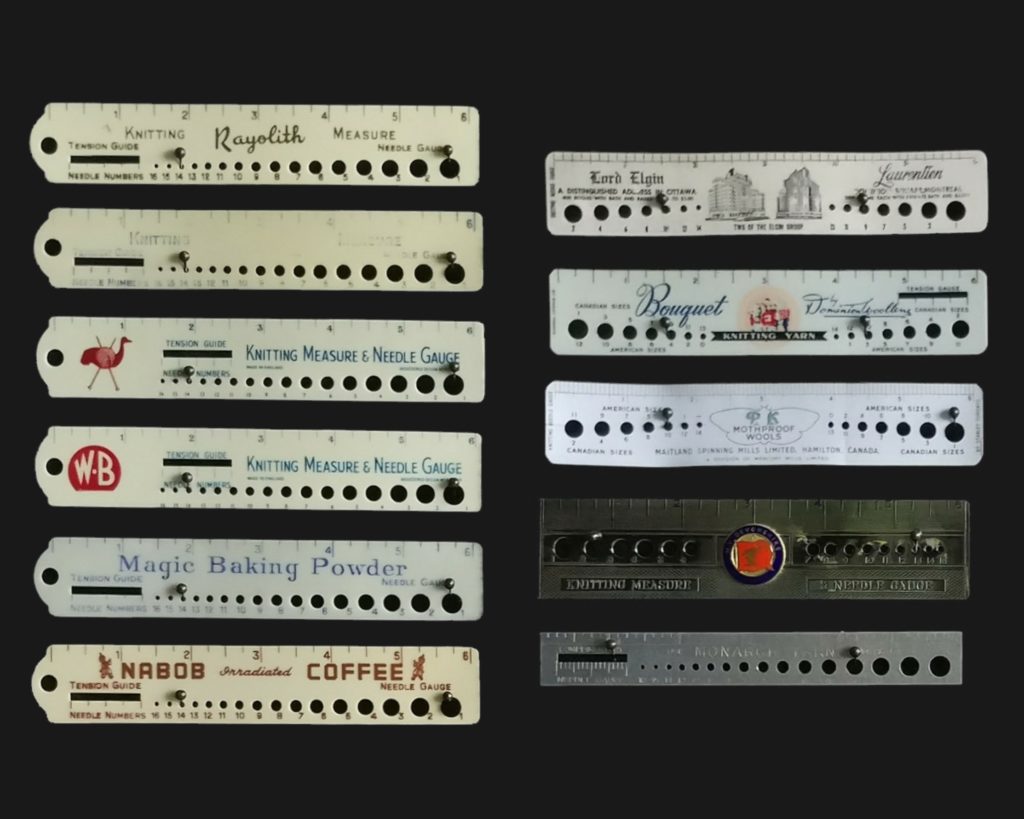
Left-hand Column
The gauges are all the same size and shape with a one-inch measuring slot and holes from 1 to 16. They also have a six-inch ruler along one edge. Emu and WB (William Briggs) are identical apart from the printing so were probably made by the same manufacturer. The other four are all alike and may all be of Canadian origin – Rayolith, unnamed, Magic Baking Powder, Nabob Irradiated Coffee.
These celluloid gauges were cheap to make and were probably all given as free gifts. They are flexible and difficult to break but they have the disadvantage that the writing sometimes wears off.
Right-hand Column
The three gauges at the top are from Canada. They have American and Canadian sizes. They are very similar in format.
- Elgin Group of Hotels. It has pictures of the Lord Elgin Hotel, Ottawa and the Laurentien Hotel, Montreal. Lord Elgin was built in 1941 and Laurentien in 1947 so the gauge probably dates from the late 1940s. It seems a strange gift for a hotel to give.
- Bouquet by Dominion Woollens. This company went into receivership in 1959 so the gauge is probably earlier than that.
- PK Mothproof Wools.
Two metal gauges
- The first has a badge which says MV Devonshire. I have been able to find information about this ship but have no idea why there should be a souvenir needle gauge.
- The other says Use Monarch Yarns For Best Results.
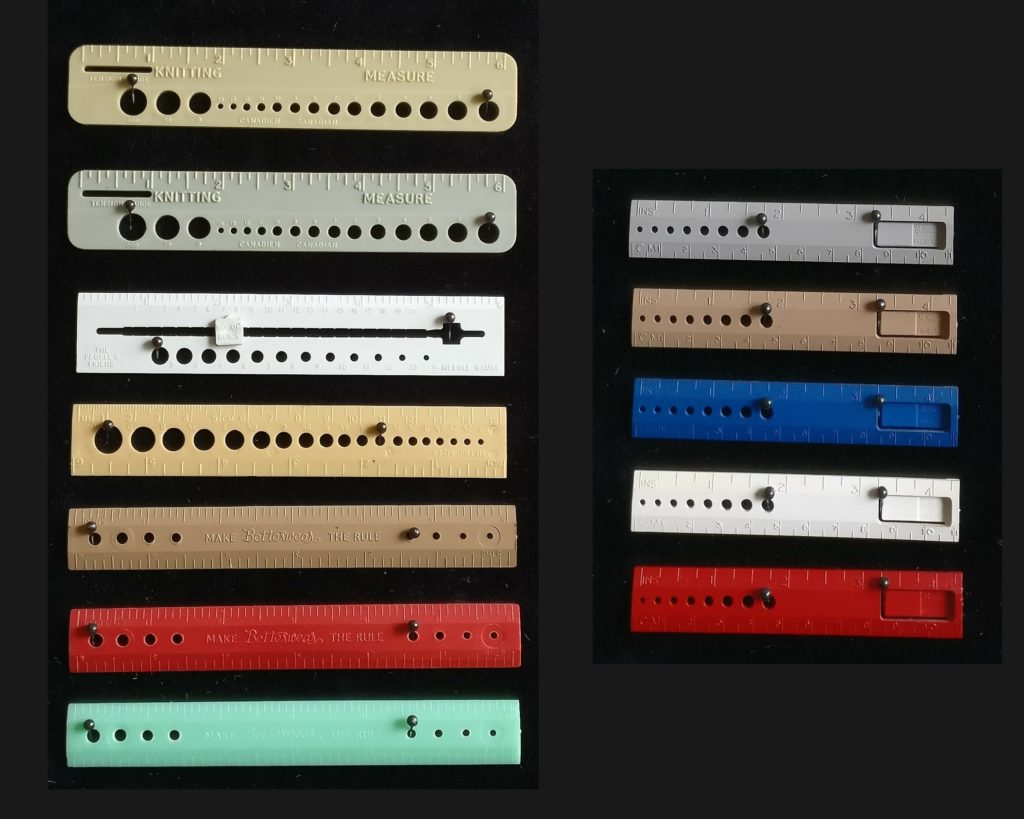
Left-hand Column
- The top two are Canadian with Canadian sizes (which are the same as British) on one side, and metric on the other. There is no indication where they came from.
- The white one was given by People’s Friend (which celebrates its 150th anniversary this year). In addition to the ruler and measuring holes, it has a slider and numbers so that you can count rows. It pre-dates metric sizing. The holes are from 3 to 14.
- Unnamed with metric and UK sizes.
- Betterwear. These came in many colours. Make Betterwear The Rule. Betterwear Knitting Needle Gauge. Free Gift. Hole sizes 7 to 14.
Right-hand Column
- Betterwear gauges. The name is not immediately obvious as it is printed on the cut-out part that is meant to act as a bookmark or pattern marker. It says Betterwear Free Gift. On the back it says Knitting Needle Gauges. Hole sizes 7 to 14.
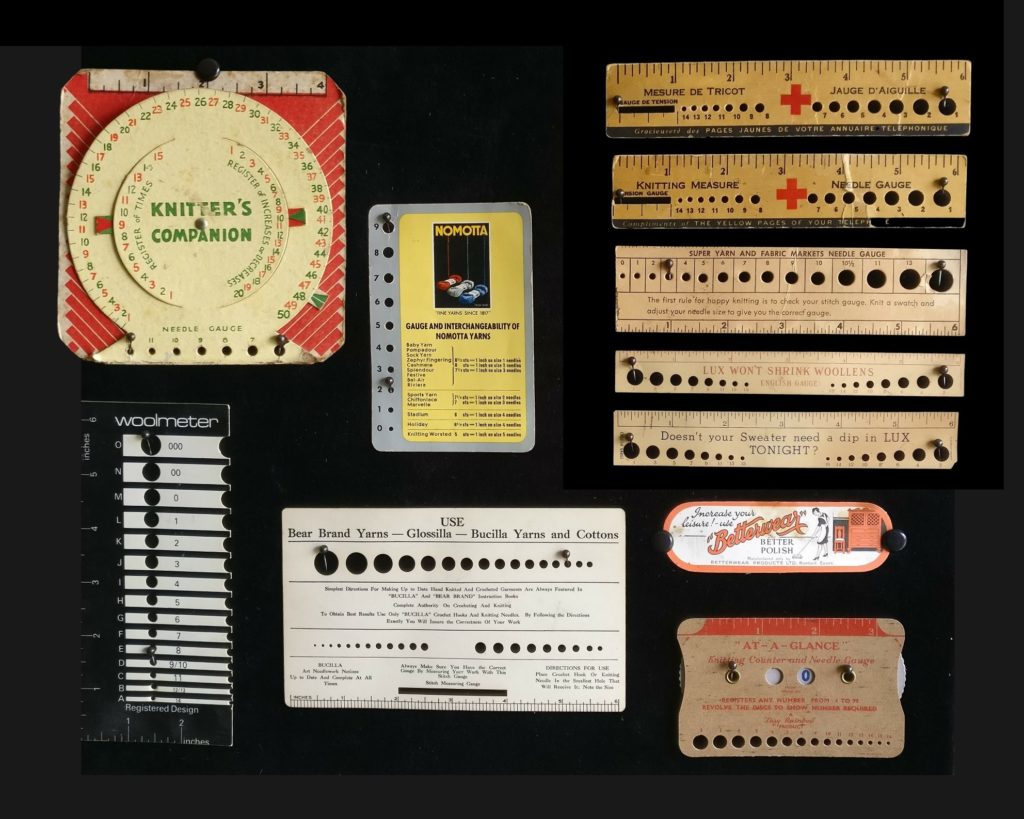
- Knitter’s Companion. Thick card. There are two rotating pointers in the centre. One is labelled Register of Times (1 to 15). The other is Register of Increases or Decreases (1 to 20). The outer circle has numbers from 1 to 50 but no caption. The hole sizes are 6 to 12 and there is a 4 inch ruler.
- woolmeter Registered Design. One side has UK sizes, a 6 inch ruler and a 2 inch ruler. The holes are the same size as the cut-outs along the edge. The other side (white background with black bars) has metric sizes and ruler. I think it was primarily a metric gauge but there are some anomalies. The UK side has one hole labelled 12/13 and another labelled 9/10. The metric side has no 3.25, which is commonly used in UK but it does have 3.5, which is not standard UK. It also has letters A to O, which are not used in UK. The holes are not stamped accurately within the stripes.
- Nomotta. Gauge and Interchangeability of Nomotta Yarns. The holes appear to be American sizes. They are from 1 to 9. On the back it says Printed in U.S. Zone of Germany. It could date from about 1949. There is a great deal of information, on the back, about washing, rinsing, blocking, etc.
- Bear Brand Yarns – Glossilla – Bucilla Yarns and Cottons. This is probably from US. It has three different gauges, which are (1) Actual Sizes of Celluloid Bone and Wood Crochet Hooks and Knitting Needles (2) Actual Sizes of Steel Circular, Steel and Aluminum Knitting Needles. Also Aluminum Crochet Hooks (3) Actual Sizes of Double Pointed Steel Needles. It also lists the sizes all their needles are made in. Both sides are covered in information including helpful advice like To Obtain Best Results Use Only “BUCILLA” Crochet Hooks and Knitting Needles. By Following the Directions Exactly You Will Insure the Correctness Of Your Work
- English and French versions (with red cross). Compliments of The Yellow Pages of Your Telephone Directory. These seem to be UK sizes 1 to 14 so the gauges probably come from Canada.
- Compliments of Your Super Yarn & Markets, Inc. On the back it has addresses of seven US stores. US sizes 0 to 15. The first rule for happy knitting is to check your stitch gauge. Knit a swatch and adjust your needle size to give you the correct gauge.
- Lux Won’t Shrink Woollens. English Gauge. 6 inch ruler. Holes 1 to 16.
- Doesn’t Your Sweater Need a Dip in Lux Tonight? Very similar to the gauge above but narrower.
- Betterwear. Very flimsy card with lines drawn on the back. To check the size of your knitting needles lay them on this accurate needle gauge. Sizes are from 1 to 24. This suggests it pre-dates any of the plastic Betterwear gauges. On the front it says Increase your leisure! – use Betterwear The Better Polish. Manufactured only by Betterwear Products Ltd., Romford, Essex.
- “AT – A – GLANCE” Knitting Counter and Needle Gauge. Very thick card with two rotating discs. Registers any number from 1 to 99. Revolve the discs to show the number required. A “Lazy Rainbow” Product. Patent Applied For. Made in England. It has a 3 inch ruler and holes from 2 to 16.
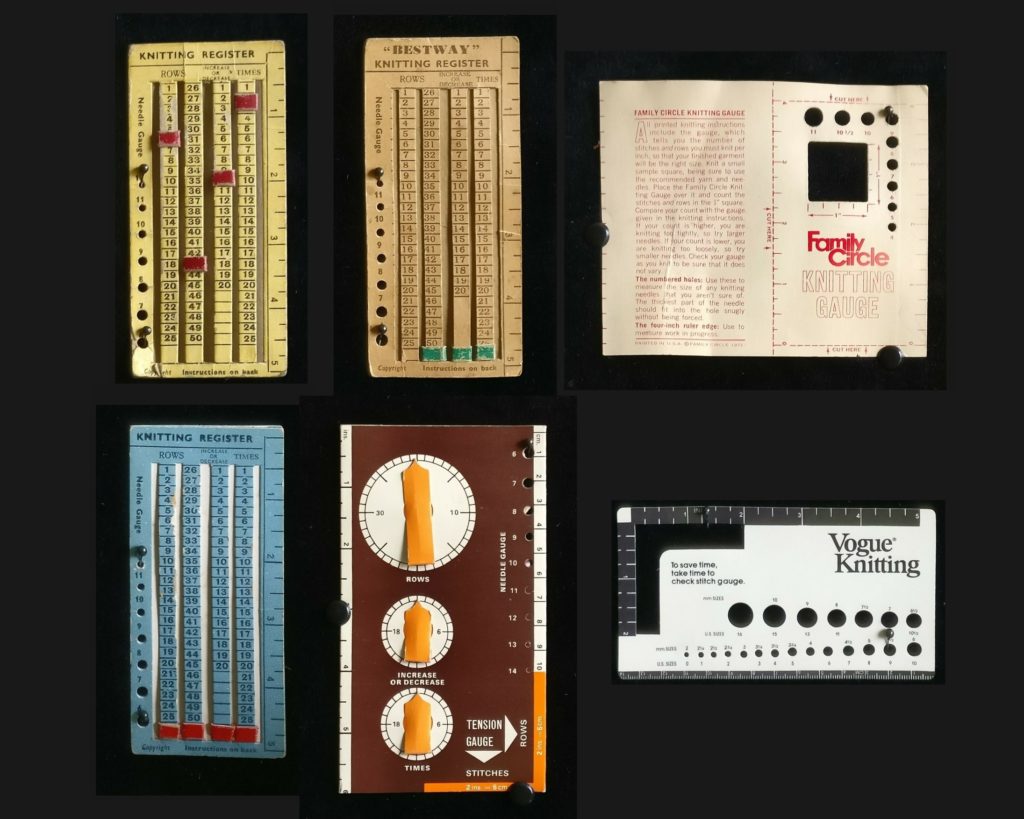
- The two on the left are exactly alike. They are called Knitting Register. The first two columns are for counting rows (1 – 50); the third column says Increase or Decrease (1 – 20 with some blank spaces at the bottom); the fourth column says Times (1 – 25). The cardboard sliders can be pushed up and down the columns. There is a 5 inch ruler. The holes are from 6 – 12.
On the back it says Knitting Register (With Needle Gauge and Measure)
A Handy Help For The War-Time Knitter
Directions
Number indicated is the one above the guide.
To register “Rows completed”, etc., move Guides with finger or with point of needle. After registering 50, go back to 1.
When casting on or casting off, use Increase or Decrease Guide.
When using fancy patterns, etc., use the Times Guide.
Keep Guides not in use on blank spaces.
WILBEE Seeries No. W2
- The next gauge is very similar except that it is called “Bestway” Knitting Register and does not say it is for the war-time knitter.
- Family Circle Knitting Gauge looks as though it was intended to be folded but there is no fold line. It has dotted lines on the top and bottom of the front half saying Cut here. I presume the aim is to cut at the top and bottom of the two 4 inch rulers. It was printed in US in 1972. The holes are US sizes 4 to 11. The other section has detailed instructions about knitting a small sample square and using the cut-out square to count the number of stitches and rows.
- Card with three orange pointers is Woman’s Weekly Knitting Register.
It was given away with the UK magazine in 1972. It has a 6 inch ruler and a 10 centimetre ruler. Strangely, on the back, the metric ruler begins with 2 inches and a label saying 2 ins = 5 cm. It does not mark 5 cm on the scale and continues from 6 to 15. One corner of back and front is marked as a tension gauge for stitches and rows. The dials are for Rows (40), Increase or Decrease (24) and Times (24). They have markings spaced all round but are only labelled on the quadrants. Hole sizes are 6 to 14. The back has instructions for use:
Use large dial for registering rows ; when 40 are completed move ‘Times’ dial to 1 and continue counting on large dial.
Register increases and decreases on centre dial. If both increases and decreases are worked simultaneously use both centre and ‘Times’ dials.
Use the ‘Times’ dial for counting pattern repeats.
Push un-numbered needles through the Needle Gauge holes – they should fit closely.
For checking tension lay the appropriate corner squarely on the knitting and count stitches one way, rows the other.
50 gramme ball of yarn equals 1¾ ounces. - Vogue Knitting To save time, take time to check stitch gauge. This is made of thin plastic. It has a 5 inch ruler, a 16 centimetre ruler, and a cut-out shape, 2 inches in each direction. There are 21 holes; 16 are marked in US sizes, 19 in metric.
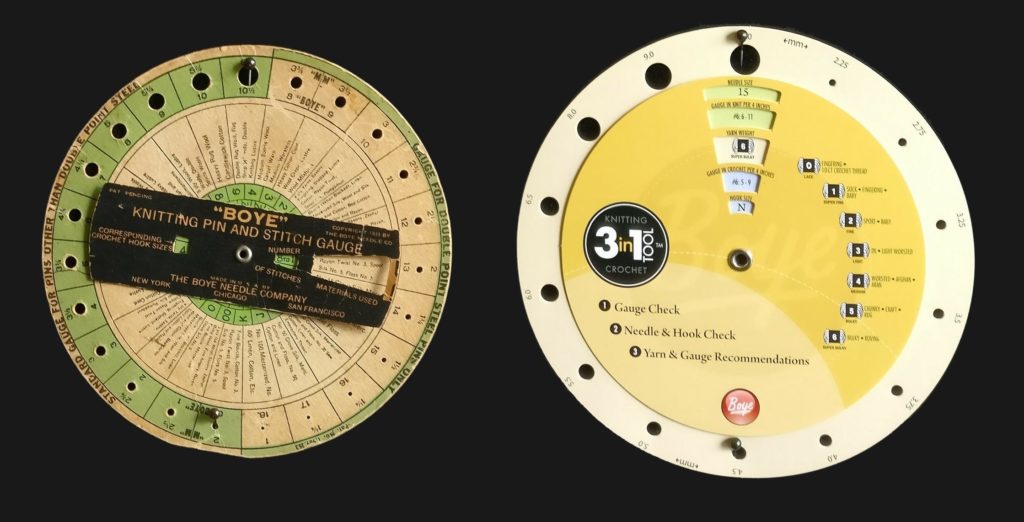
Old Boye
Front has a huge amount of information, including a copyright date 1933.
Two gauges. One is for Double Point Steel Pins Only (Sized in millimetres from 1 to 3¾ and Boye from 8 to 18, 8 being the largest); the other is Standard Gauge For Pins Other Than Double Point Steel (Sized in millimetres from 2 to 6½ and Boye from 0 to 10½, with 10½ being the largest)
The cream-coloured ring lists many different yarns, in very small print.
The rotating black bar has a lot of writing. Against one of the windows it says Corresponding Crochet Hook Sizes (Some of the sizes are numbers, some are letters). Another says Number of Stitches (Some of these give the number of stitches in 1″, others are in 2″). The bigger hole says Materials Used.
The sizes of hooks and the number of stitches are on the two green rings under the black bar.
Back has a 1 inch ruler, information about lengths and sizes of all Single Point Steel, Double Point Steel, Single Point Non-inflammable Composition, and Double Point Non-inflammable Composition Circular, needles. It also has lots of helpful advice.
This gauge is regulated to indicate sizes for even, medium, flat knitting, with sizes of crochet hooks to correspond. A tight worker uses one size larger pin or hook – A loose worker one size smaller than gauge specified.
Dont’s (sic) for Knitters. (1) Never bend a circular pin before starting work. It will take its own curvature as work progresses. (2) Never begin work without first making a 2″ sample square to test work. Wash and block, then measure and compare with Stitch Gauge. In measuring work it should be allowed to hang naturally with pin against top edge of yard stick or tape measure. — Always allow 4″ to 5″ more than natural waist measurement so that garment will slip over body.
After reading all that I am surprised anybody ever managed to knit anything.
Modern Boye
Front
3 in 1 Tool, (1) Gauge Check (2) Needle & Hook Check (3) Yarn & Gauge Recommendations
Holes in millimetres from 2.25 to 10.
One rotating dial with five windows – Needle Size, Gauge in Knit per 4 inches, Yarn Weight, Gauge in Crochet per 4 inches, Hook Size. The yarn weights are also listed on icons with numbers.
Back
Two 4 inch rulers to form the sides of a square.
Instructions To Determine Stitch Gauge and To Determine Row Gauge. These are well laid out and much as you would expect.
I think the ruler ones are very useful. The one I use most is a modern ruler gauge which has inches, centimetres and the holes marked in old English numbers, metric and US sizes which I find particularly helpful.
I’m interested in the ones with the red crosses. Are they anything to do with the actual Red Cross do you think? I’m also asking my daughter who’s the Archivist for the British Red Cross to see if she knows anything about them.
I knew she was an archivist but didn’t realise that it was for the Red Cross. It feels as though there should be a connection but I don’t know of one. I can’t imagine what it would have to do with Yellow Pages.
I posted a close-up on Twitter https://twitter.com/matheknitician/status/1123514358657630209/photo/1
https://bce.ca/about-bce/history/a-brief-history-of-the-yellow-pages-directory
This page from Bell Canada has a brief explanation for the Canadian Yellow Pages gauges. I was looking for some information because I found one in my mother’s sewing box. It must have been her mother’s